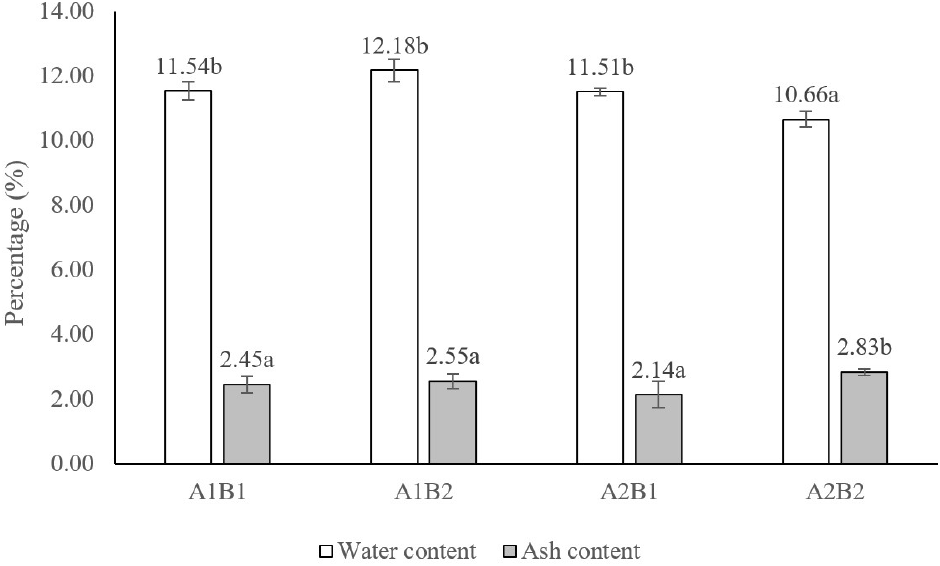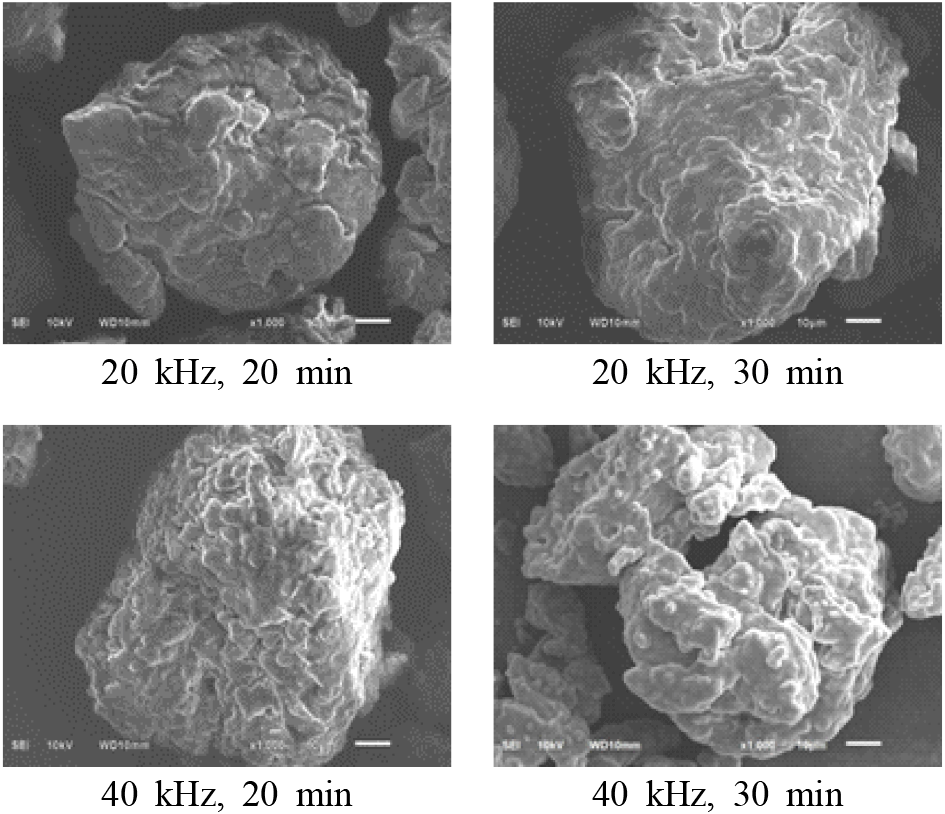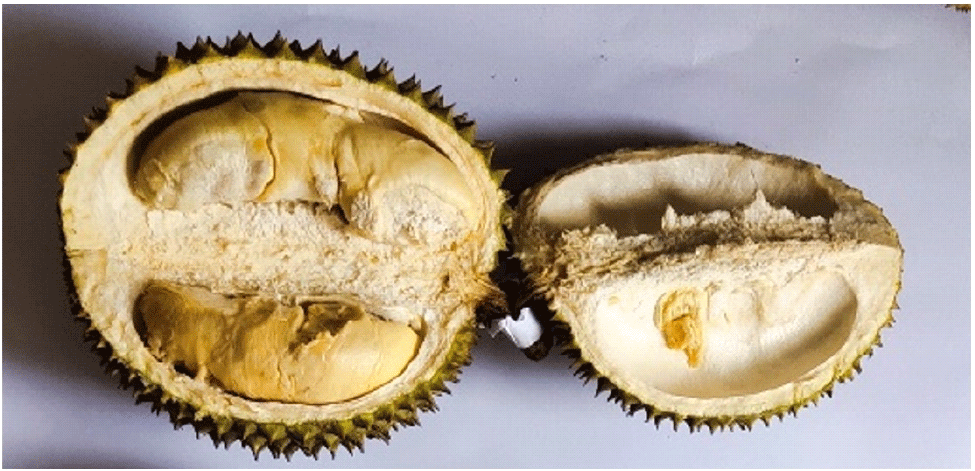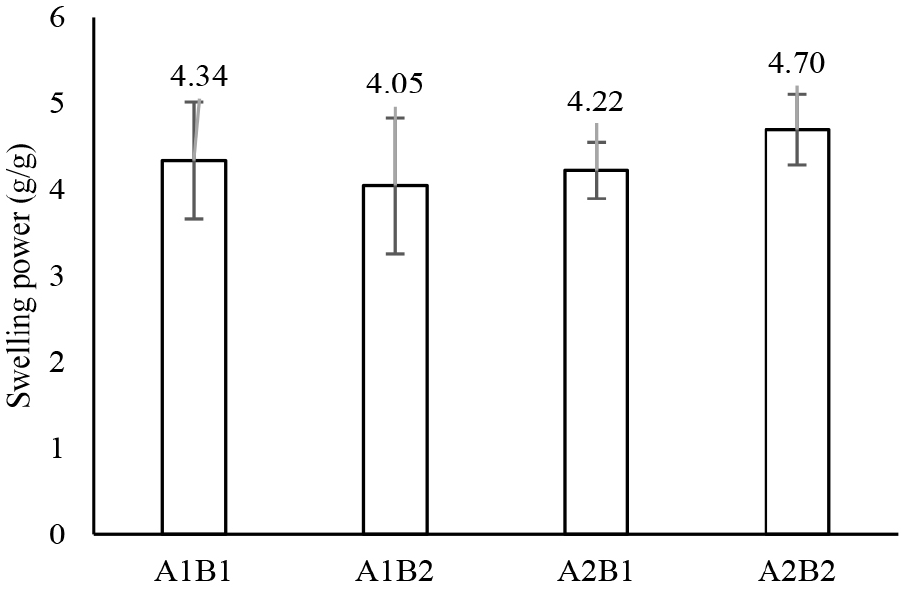1. Introduction
Durian is a tropical fruit with a typical appearance of spiny outer skin and a distinctive aroma of its flesh. Durian flesh has a short shelf life due to its high water content. Therefore, it needs further processing to extend the storage time. The size of the local durian fruit is smaller than commercial sale durian. Therefore, this local durian fruit is only for sale to a limited group of people in Lahat. There are several varieties of local durian in Lahat, and a variety of Kimsel was used in this experiment. One way to use durian flesh, especially when the harvest is abundant, is to dry the durian flesh into flour. Durian contains a high sugar content that makes it susceptible to browning when drying. Previous research on processing durian flesh flour was carried out using oven drying which was preceded by soaking in chemicals to prevent browning. Usually, sodium metabisulphite or salt is used prior to drying in order to inhibit the browning reaction (Br Sembiring et al., 2020).
Current food processing practices recommend avoiding the use of chemicals; therefore, another alternative approach is to use an environmentally friendly method, namely ultrasonic waves. Ultrasonic wave is applied prior to drying durian flesh with the aim of inactivating enzymes and breaking the bonds in the durian flesh, thereby shortening the drying time. Based on a study from Rathnakumar et al. (2023), sonication can inactivate enzymes in various vegetables, fruits, and dairy products. Xu et al. (2022) also reported that the application of ultrasonic waves could inactivate enzymes and improve the quality of rehydration, flavor, and color in sonicated cut pineapples. Furthermore, Xu et al. (2022) stated that the application of ultrasonics was able to inhibit the Maillard reaction in drying Tremella (Tremella fuciformis Berk). Pandiselvam et al. (2023) showed that the use of ultrasonic waves before product drying can increase the lightness of dried shiitake mushrooms. Ultrasonic waves (20 kHz) have also been demonstrated to maintain color intensity in Amla (Emblica officialis) fruit juice (Aslam et al., 2023). The frequency of ultrasonic waves commonly used as pre-treatment before drying ranges from 20-40 kHz (Pandiselvam et al., 2023). Sonication treatment (40 kHz; 300 W) before drying cut ginger could also accelerate drying time compared to samples without sonication treatment (Zhang et al., 2023). Previous research has also combined ultrasonic waves with other methods in the drying process such as a combination of ultrasonic waves and intermediate-waves infrared to dry agricultural products.
Based on the mechanism of ultrasonic wave, which can inhibit the browning process, the ultrasonic wave is used as a preliminary process before drying. Several factors might influence the ultrasonication method, such as frequency, temperature, power, and duration of sonication (Zia et al., 2022). So far, there is no information found on the characteristics of durian flesh flour after exposure to ultrasonic waves. This research focused on drying durian flesh into flours based on variations in frequency and sonication time which was an environmentally friendly process. Processing durian flesh flour by preceding ultrasonic waves on the durian flesh is expected to maintain product quality with minimal changes, therefore maintaining similar properties to that of fresh durian flesh. In this study, we assessed the characteristics of durian flesh flour (Durio zibethinus Murr.), which was preceded by ultrasonic waves prior to drying.
2. Materials and methods
The local durian of the Kimsel variety was harvested from Pagar Jati village, Lahat Regency, south Sumatera, Indonesia, in June 2023. Durian flesh was separated from seeds and stored in a cold room prior to further processing into flour. The Kimsel variety durian fruit has an average height of 21 cm and a width of 8 cm, with an average of 19 seeds per fruit. The weight of the durian flesh and seed of the Kimsel variety was 900 g. The yellow color of durian flesh was quite striking as seen in Fig. 1.
A 100 g sample of durian flesh was weighed and sealed in nylon plastic packaging. The sealed sample was then placed in an ultrasonic bath, which was set to the predetermined frequency and sonication time. The frequencies used were 20 kHz (denoted as A1) and 40 kHz (denoted as A2), whereas the sonication times were 20 (denoted B1) and 30 (denoted as B2) min. The sonicated samples were dried in an oven for 12 h at 55±2°C. Afterward, the dried samples were crushed in a blender, and the flour was sieved using a 40-mesh sieve. The flour that passed through the sieve was then analyzed for its characteristics.
TSS was measured using a hand-held digital refractometer (PAL-1, ATAGO Co., Ltd., Tokyo, Japan). A drop of distilled water was dripped onto the prism for calibrating before the measurement, and the distilled water was then wiped off. Durian flour was diluted in distilled water with a ratio of 1:10. Approximately 2 drops of the durian flesh flour solution were placed onto the prism. TSS was expressed as °Brix multiplied by the dilution factor. There were triplicates for each sample.
The water content (WC) of durian flesh flour was measured based on the gravimetric method by using an oven drying procedure. Five grams (W1) of durian flesh flour in an uncovered pre-weight porcelain crucible was oven-dried at 105°C overnight. After drying, the porcelain crucible was covered with a lid and cooled in desiccators containing silica gel for two hours before weighing. The dried sample was weighed as W2. WC was calculated using the expression in (1):
where W1 and W2 are the weight of initial sample (g) and dried sample (g), respectively.
The ash content (AC) of durian flesh flour was measured by using the samples prepared for MC. The sample in the porcelain crucible was burned in a muffle furnace until the sample turned into white ash, which was then weighed (W3).
Swelling power was analyzed as described by Jia et al. (2023). Briefly, an amount of 0.5 g durian flesh flour was put in a 50 mL test tube. After the addition of 25 mL of distilled water, the tube was heated at 60°C in a water bath for approximately 30 min. The test tube was then centrifuged at 16,000 ×g for 15 min. The precipitated part at the bottom of the test tube was weighed. The swelling power was calculated as the weight of the precipitated part per the amount of sample.
The SEM-EDS analysis was performed using an electron microscope at the Institute of Technology, Bandung, Indonesia. The procedures as described by Aritonang et al. (2014) with some modifications. Briefly, the sample was coated with a conductive metal (gold). The coated sample was then placed on an SEM microscope and observed at 1,000 times magnification at 10 kV accelerating voltage.
A completely randomized factorial design was employed, incorporating two factors, with each treatment replicated three times. The first factor involved sound wave frequency, with levels of 20 kHz (A1) and 40 kHz (A2), while the second factor was the exposure duration to sound waves, consisting of 20 (B1) and 30 (B2) min. The collected data were analyzed using analysis of variance (ANOVA), and statistical significance was further assessed using Tukey’s test at the 5% significance level. The results are presented as the mean of triplicates.
3. Results and discussion
Total soluble solids (TSS) serve as a crucial quality parameter for durian, representing the overall concentration of soluble compounds, including organic acids, amino acids, and pectin, with sugars being the predominant component. The treatment condition A1B1 (20 kHz, 20 min) exhibited the highest TSS value, demonstrating a statistically significant difference (p<0.05) compared to other treatments. This finding suggests that ultrasonic waves can facilitate the reduction of soluble components in durian flesh during processing. Furthermore, TSS levels decrease as both ultrasonic frequency and sonication duration increase (Fig. 2.).

A measurement of TSS using a refractometer with units of brix means that it is equivalent to showing milligrams of sugars per 10 g of material. The sugars content in durian flesh can vary among different durian cultivars. The initial TSS of durian flesh before processed into flour was 25 °Brix. Khaksar et al. (2024) reported that the TSS of durian flesh was between 8 to 20 °Brix depending on the durian variety and that sucrose was the major sugar component in durian flesh. The TSS content in durian flesh flour is significantly lower than that in fresh durian flesh. The TSS value, which reaches approximately 20 °Brix in fresh durian, is reduced by 50% during the flour processing. Ultrasonic waves create high-frequency pressure variations in the liquid medium, leading to the formation and collapse of microbubbles which is known as cavitation. Cavitation generates localized high temperatures and pressures that can disrupt cellular structures in the durian flesh, facilitating the release of soluble solids. The extent of TSS reduction is also influenced by factors such as the duration and intensity of ultrasonic treatment. Prolonged exposure to ultrasonic waves can lead to excessive breakdown of cell walls, resulting in a more significant loss of soluble solids from the flour (Bekele and Admassu, 2022). This phenomenon can be attributed to the removal of water during the processing of durian flour, which leads to the concentration of soluble solids. Consequently, a decrease in water content results and an increase in TSS were due to the enhanced concentration of sugars, organic acids, and other soluble compounds.
Water content is a key determinant of the shelf life of durian flour, as elevated moisture levels accelerate spoilage and decrease storage stability. By measuring the water content, it is possible to optimize the storage conditions and ensure that the durian flour has an acceptable shelf life. Ash content is a measure of the inorganic minerals and salts present in the flour, which can affect the nutritional value of the product. Tukey’s test revealed that the A2B2 treatment exhibited a statistically significant difference (p<0.05) in both water and ash content compared to the other treatments in durian flour. The detailed water and ash content of all treatments can be seen in Fig. 3.

So far, the properties of durian flesh powder have not been reported; much research has been carried out on durian seeds. Faridah et al. (2021) studied the physicochemical properties of durian seed flour, and they further reported that the water content of durian seed flour was around 10%, and ash was in the range of 4 to 4.8%. Similarly, Abdullah et al. (2021) stated that the water content of durian seed flour was 9.861%, and the ash content was 6.826%. When comparing the properties of durian flesh flour and durian seed flour, there were similarities in the amount of water and ash content. The water and ash content of the flour decreases when compared to the material before drying because the water is evaporated and minerals are leached out. The process of releasing water and ash is accelerated by cavitation from sound waves during the pre-treatment process.
ANOVA showed that the treatment did not significantly affect the SP. The swelling power of durian flesh flour can vary depending on factors such as durian variety and processing methods. Currently, no literature specifically reports the swelling power of durian flesh flour, as most studies focus on durian seed flour. However, starches with high amylopectin content, such as sago and tapioca starch, exhibit the highest swelling power, reaching approximately 30 g/g. As shown in Fig. 4, the swelling power of durian flesh flour ranged from 4 to 5 g/g. The low SP of all samples might be due to the low content of starch in the ripe durian flesh. SP indicates the ability of a flour to absorb water and expand. In the case of durian flesh flour, the SP can be affected by various factors such as the ripeness of the fruit and processing methods. The information on SP for durian flesh flours can help manufacturers optimize the processing conditions, storage methods, and flour compositions to achieve the desired properties in the final product. Additionally, understanding the SP of durian flesh flours can also contribute to the development of new food products or the improvement of existing ones, as it can provide insights into the potential applications and limitations of durian flour in the food industry. The SP of all samples is shown in Fig. 4.
The SP of durian flesh fours was low; this may be due to the components in durian flour being not only starch but also sugar and acid components. As reported by Baraheng and Karrila (2019), starch with higher amylopectin content generally exhibits greater SP compared to amylose, which has a linear structure. Durian flour, like other flours, contains starch, which has swelling properties when mixed with water and heated. The pre-treatment of ultrasonic waves on fresh durian flesh can increase the permeability of starch granules due to cavitation, allowing for more efficient water absorption. This can potentially lead to higher swelling power in some cases. Even though the SP values were not significantly different, as shown in Fig. 4, it shows that a higher frequency and a longer sonication period resulted in a higher SP.
The microstructure of durian flour was observed using SEM at 1,000 times magnification, as shown in Fig. 5. SEM observations showed similar structural morphology of semi-round for all samples. Longer sonication times resulted in more compact of the flour’s granules. Long periods of ultrasonication can cause the structure to become loose or more porous. The ultrasonication process can break the bonds between element components, therefore causing the structure to appear loose. Elements Cr, Fe, Ni, Cu, and Mo were detected only in the durian flesh flour subjected to 20 kHz frequency for 20 min. Other treatments detected only C and O elements, as depicted in Table 1.

A considerable amount of C and O were detected in samples A1B2, A2B1, and A2B2 but not in sample A1B1. It might be due to the comparatively high amount of other trace elements in sample A1B1 (low frequency and short sonication time). The absence of Nitrogen in the element profiling indicated that the durian flesh flour did not contain proteins. Instead, it seemed to have more carbohydrates.
4. Conclusions
Durian flour exhibited a water content of 10-11%, ash content of 2-3%, total soluble solids of 10-11%, and a swelling power of 4.34-4.70 g/g. Ultrasonication effectively altered the flour’s structure, creating a more porous texture by disrupting granular bonds. Elemental analysis confirmed the presence of carbon and oxygen across all treatments, while sulfur, chromium, iron, nickel, copper, and molybdenum were exclusively detected in the 20 kHz, 20-min sonication treatment. Durian flesh flour can be utilized as a topping for ice cream or incorporated into cake formulations to enhance the durian aroma in the food industry.


